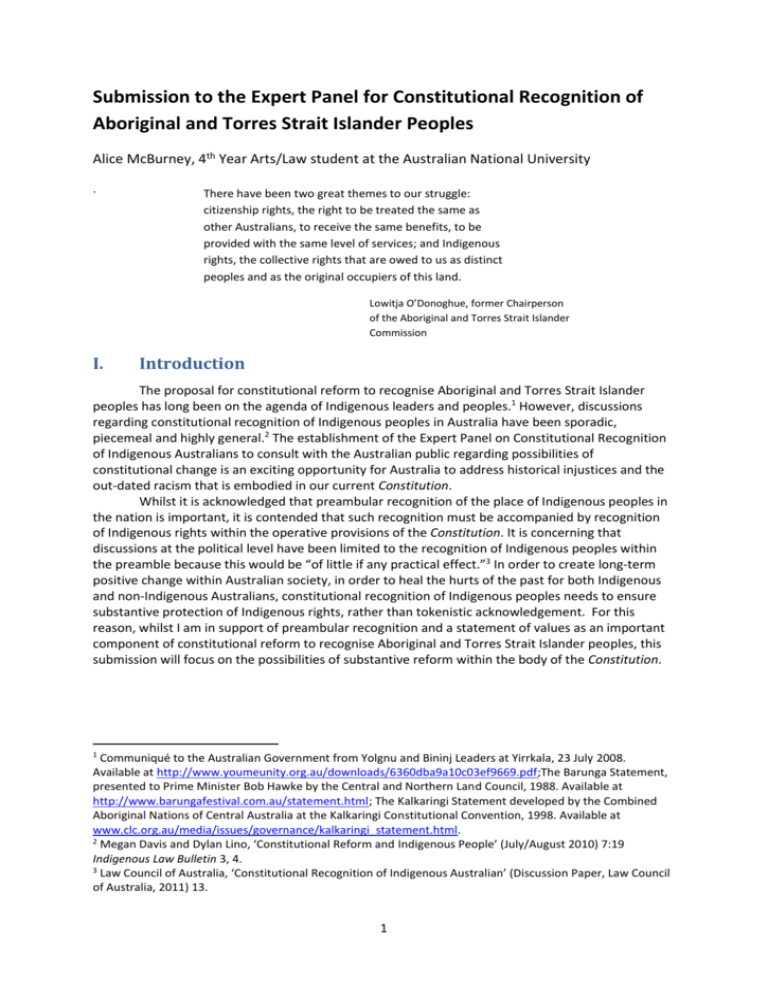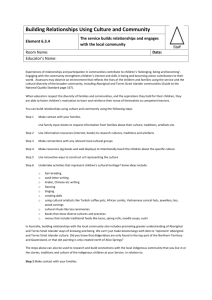Constitutional reform to recognise Indigenous peoples in the
advertisement

Submission to the Expert Panel for Constitutional Recognition of Aboriginal and Torres Strait Islander Peoples Alice McBurney, 4th Year Arts/Law student at the Australian National University . There have been two great themes to our struggle: citizenship rights, the right to be treated the same as other Australians, to receive the same benefits, to be provided with the same level of services; and Indigenous rights, the collective rights that are owed to us as distinct peoples and as the original occupiers of this land. Lowitja O’Donoghue, former Chairperson of the Aboriginal and Torres Strait Islander Commission I. Introduction The proposal for constitutional reform to recognise Aboriginal and Torres Strait Islander peoples has long been on the agenda of Indigenous leaders and peoples.1 However, discussions regarding constitutional recognition of Indigenous peoples in Australia have been sporadic, piecemeal and highly general.2 The establishment of the Expert Panel on Constitutional Recognition of Indigenous Australians to consult with the Australian public regarding possibilities of constitutional change is an exciting opportunity for Australia to address historical injustices and the out-dated racism that is embodied in our current Constitution. Whilst it is acknowledged that preambular recognition of the place of Indigenous peoples in the nation is important, it is contended that such recognition must be accompanied by recognition of Indigenous rights within the operative provisions of the Constitution. It is concerning that discussions at the political level have been limited to the recognition of Indigenous peoples within the preamble because this would be “of little if any practical effect.”3 In order to create long-term positive change within Australian society, in order to heal the hurts of the past for both Indigenous and non-Indigenous Australians, constitutional recognition of Indigenous peoples needs to ensure substantive protection of Indigenous rights, rather than tokenistic acknowledgement. For this reason, whilst I am in support of preambular recognition and a statement of values as an important component of constitutional reform to recognise Aboriginal and Torres Strait Islander peoples, this submission will focus on the possibilities of substantive reform within the body of the Constitution. 1 Communiqué to the Australian Government from Yolgnu and Bininj Leaders at Yirrkala, 23 July 2008. Available at http://www.youmeunity.org.au/downloads/6360dba9a10c03ef9669.pdf;The Barunga Statement, presented to Prime Minister Bob Hawke by the Central and Northern Land Council, 1988. Available at http://www.barungafestival.com.au/statement.html; The Kalkaringi Statement developed by the Combined Aboriginal Nations of Central Australia at the Kalkaringi Constitutional Convention, 1998. Available at www.clc.org.au/media/issues/governance/kalkaringi_statement.html. 2 Megan Davis and Dylan Lino, ‘Constitutional Reform and Indigenous People’ (July/August 2010) 7:19 Indigenous Law Bulletin 3, 4. 3 Law Council of Australia, ‘Constitutional Recognition of Indigenous Australian’ (Discussion Paper, Law Council of Australia, 2011) 13. 1 II. The Need for Constitutional Reform Our Constitution still contains provisions that allow for adverse discrimination on the basis of race. Section 25 suggests that an Australian voter could be excluded from voting on the basis of race. This is an example of express and overt adverse discrimination on the basis of race. The races power contained in s51(xxvi) allows for the Commonwealth to make laws with respect to “the people of any race for whom it is deemed necessary to make special laws.” This provision was subject to reform during the 1967 referendum, which removed the words “other than the aboriginal race” from the text of s51(xxvi) and empowered the Commonwealth to make laws with respect to Indigenous peoples on the basis of their status as a racial group. The Yes vote advocates believed that this constitutional change would result in the passing of laws in the interests of Indigenous peoples.4 In Tasmanian Dams, Brennan J acknowledged that the original form of s51(xxvi) permitted adverse discrimination against racial groups,5 however commented on the need to reinterpret the power in light of the 1967 referendum, which was “an affirmation of the will of the Australian people that the odious policies of oppression and neglect of Aboriginal citizens were to be at an end, and that the primary object of the power is beneficial.”6 Despite the overwhelmingly positive symbolism of the 1967 referendum, the resulting silence on the rights of Indigenous peoples allowed for s51(xxvi) to be used to pass laws detrimental to Indigenous people,7 which was supported by the High Court’s interpretation of the power in Kartinyeri.8 The Hon Robert French, after detailed analysis of High Court jurisprudence on s51(xxvi) concluded that there was nothing in the power “to prevent its adverse application to Australian citizens simply on the basis of their race.” 9 For these reasons, s25 and s51(xxvi) must be repealed in order to eliminate the out-dated and highly problematic use of race as a criterion in the Constitution that permits adverse discrimination on the basis of race. III. A new head of power for Indigenous peoples? The elimination of s51(xxvi) would leave limited scope for the Commonwealth to pass laws with respect to Aboriginal and Torres Strait Islanders, except perhaps via the external affairs power. However, it is contended that for the Australian Government to be able to effectively reconstitute its relationship with Indigenous peoples, it needs to be able to pass legislation specific to Indigenous peoples and in order to avoid uncertainty, a provision empowering the Commonwealth to make laws with respect to Aboriginal and Torres Strait Islander peoples should be inserted into the Constitution. The Hon Robert French argued that such a power would not be open to adverse discrimination on the basis of race because laws made under it would be “based not on race but on the special place 4 Brian Attwood and Andrew Markus, ‘Representation Matters: The 1967 Referendum and Citizenship’ in J Altman and M Hinkson (eds), Citizenship and Indigenous Australians: Changing conceptions and possibilities (Cambridge University Press, 1998) 118 -119. 5 See George Williams, ‘Race and the Constitution: From Federation to Reconciliation’ (2000) 38:4 Osgoode Hall Law Journal 643. 6 Commonwealth v Tasmania (1983) 158 CLR 1, 537. 7 For example, the passing of the Native Title Amendment Act 1998 (Cth), which prevented the Racial Discrimination Act 1975 (Cth) from applying to certain sections of the Native Title Act 1993 (Cth). 8 Kartinyeri v Commonwealth (1998) 195 CLR 337. 9 The Hon Justice Robert French, ‘The Race Power: A Constitutional Chimera’ in H.P. Lee and George Winterton G (eds), Australian Constitutional Landmarks (Cambridge University Press, 2003) 180, 206. 2 of those peoples in the history of the nation.”10 Unlike the 1988 Constitutional Commission and as endorsed by the Hon Robert French, the wording of the new power could not be limited to “Aboriginal and Torres Strait Islander peoples.” Rather, the new head of power should be based on the culture, historical disadvantage and the unique place of Aboriginal and Torres Strait Islander peoples as the descendants of the original owners and occupiers of Australia. However, even if the new provision contained this wording, it would still be up to our legal system, Parliament and the courts, to determine the meaning of the words. In order to ensure that the new head of power is not used to discriminate adversely against Indigenous peoples, there needs to be additional protective mechanisms inserted into the Constitution to ensure that it is used on the basis of equality and consent. IV. A Constitutional Treaty-Making Mechanism RECOMMENDATION 1: It is proposed that a new power to make laws with respect to Aboriginal and Torres Strait Islander peoples should be inserted only if it is expressly subject to a constitutional treaty-making provision. It is not envisaged that the national treaty would contain substantive content, but instead a procedural framework to facilitate the negotiation of treaties with Indigenous peoples at the local or regional level and then provide these agreements with legal protection.11 The treaty should have three components: a) A framework for negotiation, which outlines the structures and policies that are required to guide more specific treaty-making. It has been suggested that this could include the possible content of the treaties, minimum standards, rights of Indigenous peoples that underpin the process, a body to oversee negotiations and dispute settlement and funding mechanisms.12 b) Legal force and protection of the treaties entered into in accordance with the framework. c) Avenue for ongoing discussion between Indigenous peoples and the Commonwealth with regards to their relationship to the State and the ability to change treaties given legal force if this change occurs in accordance with the negotiation framework. The importance of enshrining a treaty-making mechanism in the Constitution is reflected in the creation of the Australian state on the doctrine of terra nullius. The Australian state was built on the pretence that there were no pre-existing systems of social and political organisation and a treaty was never entered between the colonisers or the original inhabitants. For these reasons, the Australian state does not have a legitimate source of power with respect to Indigenous peoples. The insertion of a head of power with respect to Aboriginal and Torres Strait Islander’s, would be inappropriate in the absence of such a treaty-making mechanism, because it would be placed in the exclusive hands of the Australian state, namely Parliament and the judiciary. Furthermore, the The rejection of the doctrine of terra nullius in Mabo necessitates the need to “engage with the underlying lack of consent sought from or provided by Aboriginal and Torres Strait Islander peoples to the acquisition of sovereignty by the Crown.”13 10 Ibid 208. 12 Sean Brennan, Larissa Behrendt, Lisa Strelein, George Williams, Treaty (Federation Press, 2005) 132. Law Council of Australia, ‘Constitutional Recognition of Indigenous Australian’ (Discussion Paper, Law Council of Australia, 2011) 13. 13 3 The prospect of treaties often conjure secessionist conceptions of sovereignty and selfdetermination, however, they don’t necessarily mean this in the context of the Indigenous claims.14A constitutional treaty would merely outline a framework in which negotiations regarding the relationship between Indigenous people and the state could proceed within the bounds of the Australian state.15 Until the fiction of terra nullius has been constitutionally recognised by a treatymaking mechanism “our occupancy of this land, our very right to be here, is tainted by the aggression against Aborigines by which it was established.”16 V. An Equality and Non-Discrimination Provision RECOMMENDATION 2: It is proposed that a new head of power with respect to Aboriginal and Torres Strait Islander peoples should only be inserted if it is expressly subject to an equality and nondiscrimination provision. The equality and non-discrimination provision should have 3 components: a) Statement that all legislation should be underpinned by the principles of equality and nondiscrimination; b) Acknowledgement that the achievement of equality and non-discrimination can require positive discrimination; c) A guarantee of recognition and legal protection of recognised Indigenous rights such as native title and those that are recognised or negotiated in the future. There is no guarantee that the new head of power could not also be interpreted by the courts as enabling the Commonwealth to pass legislation adverse to Indigenous peoples. Even with an express limitation, such as with respect to “matters beneficial to” or “the benefit of” Aboriginal and Torres Strait Islander peoples, the decision as to what constitutes beneficial would remain in the hands of Parliament and the courts. To protect against the possibility of such adverse discrimination, such a head of power should also be expressly subject to an equality and non-discrimination provision. It is important to note that the insertion of an equality and non-discrimination provision would be beneficial to all Australians, not just Indigenous peoples. An equality and nondiscrimination provision would prevent the new head of power from being used for adverse discrimination. However, it is clear that a traditional equality and non-discrimination provision would be insufficient to protect Indigenous rights. It would need to incorporate the fact that the achievement of equality, particularly with respect to a group that has historically experienced dispossession, destruction and discrimination, often requires measures of positive discrimination. The current Government does employ measures of positive discrimination to carry out their policy of “closing the gap” between Indigenous and non-Indigenous Australians. In addition, it is important that such a provision enables the recognition of Indigenous peoples for their unique historical and cultural difference, rather than merely the assimilation of Indigenous peoples into the ‘modern’ state through mechanisms of socio-economic development. To do this, it must provide legal protection to recognised Indigenous rights, such as native title and rights that are recognised or negotiated in the future. The protection of Indigenous rights, which arise due to a person’s status as a descendent of first peoples are just as important as substantive equality within our system of governance. There is a causal connection between the recognition and protection of rights and Indigenous well-being. Adequate protection of Indigenous interests must extends beyond orthodox notions of equality and non-discrimination to the recognition and protection of Indigenous difference. 14 Larissa Behrendt, Achieving Social Justice: Indigenous Rights and Australia’s Future (Federation Press, 2003) 18. 15 Bain Attwood and Andrew Markus, 1967 Referendum: Race, Power and the Australian Constitution (Aboriginal Studies Press, 2nd edition, 2007) 75. 16 H.C. Coombs, Aboriginal Autonomy: Issues and Strategies (Cambridge University Press, 1994) 143. 4 VI. Conclusion Constitutional reform to recognise Indigenous peoples in the Constitution requires time, education and wide consultation with all sectors of Australian society, particularly Indigenous peoples.17 It may be important for the consultation and educational functions of the Expert Panel to be extended beyond the 43rd Parliament in order to ensure that unlike the case of the 1967 referendum, we get it right. This submission has argued that whilst symbolic recognition of Indigenous peoples within the Constitution is important, it must be coupled with substantive changes within the body of the Constitution that will act to protect Indigenous rights. It is proposed that s25 and s51(xxvi) should be repealed. A head of power with respect to Indigenous peoples should be inserted into the Constitution and expressly based on the culture, historical disadvantage and the unique place of Aboriginal and Torres Strait Islander peoples as the descendants of the original owners and occupiers of Australia. This power should be expressly subject to a constitutional treaty-making mechanism and an equality and non-discrimination provision, as outlined above. 17 The 1995 Social Justice Package reports from ATSIC, the Council for Aboriginal Reconciliation and the submission of the then Aboriginal and Torres Strait Island Social Justice Commissioner, Mick Dodson all emphasised the importance of education, consultation and negotiation processes in the lead up to constitutional reform. 5







